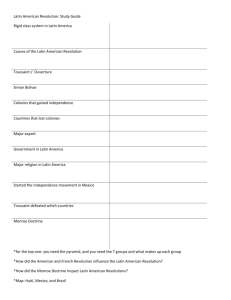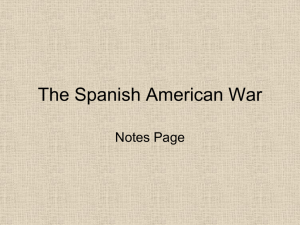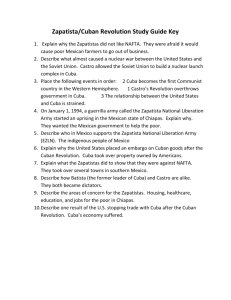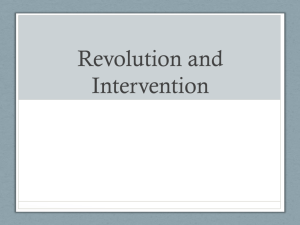click here to view powerpoint
advertisement
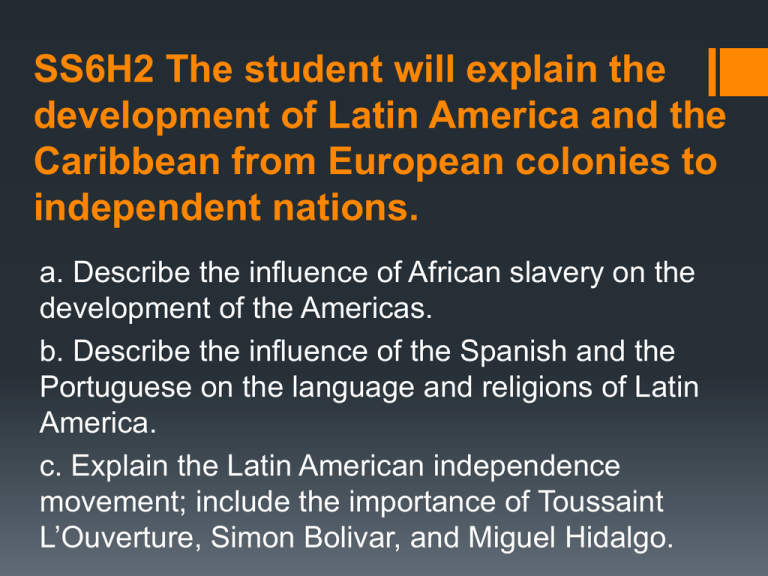
SS6H2 The student will explain the development of Latin America and the Caribbean from European colonies to independent nations. a. Describe the influence of African slavery on the development of the Americas. b. Describe the influence of the Spanish and the Portuguese on the language and religions of Latin America. c. Explain the Latin American independence movement; include the importance of Toussaint L’Ouverture, Simon Bolivar, and Miguel Hidalgo. SS6H2a-African Slavery Europeans who came to the Americas needed a large & cheap labor force to mine gold and silver and to grow sugar cane. Most natives died from diseases, violence with Europeans, or harsh working conditions. Europeans looked to Africa for labor. Many African slaves died of disease or starvation. SS6H2a-African Slavery Slave labor helped to build many businesses in Latin America, but the wealth went back to Europe. Countries started gaining freedom from Europe in the 1800s, ending slavery. Mulattoes = African & European ancestors 60% Cubans & 50% Brazilians are Mulattoes SS6H2b-Language & Religion As the Spanish and Portuguese conquered the indigenous people, they spread their language and religion. Spanish: Most of Central & South America and the Caribbean Islands Portuguese: Brazil Spanish or Portuguese = languages of government, business, and power Native languages still spoken today SS6H2b-Language & Religion Mostly Roman Catholic Spanish & Portuguese governments sent missionaries to New World to convert indigenous people to Christianity Indigenous people often “said” they were practicing Catholicism, but continued to practice traditional beliefs Some religions mixed with Catholic beliefs SS6H2c-Independence Movement Spain & Portugal ruled most of Latin America for nearly 300 years American Revolution in 1776 & French Revolution in 1789 encouraged Latin American countries to seek freedom SS6H2c-Independence Movement Toussaint L’Ouverture Famous black freedom fighter in Saint Domingue (present day Haiti) Learned about freedom from his father Plantation owner allowed him to read & write L’Ouverture - nickname because he could find “openings” in the enemies’ lines SS6H2c-Independence Movement 1789=French Revolution – granted freedom to blacks & mulattoes 1791=French gov’t changed its mind Toussaint led slave army & defeated French troops 1793=French abolished slavery altogether so Toussaint fought against Spanish & British Toussaint left in charge of Saint Domingue 1802=Toussaint was captured & imprisoned in France (where he died soon after) SS6H2c-Independence Movement Simon Bolivar Known as “Liberator” and “George Washington of South America” Helped win independence for Bolivia, Colombia, Ecuador, Panama, Peru, and Venezuela between 1810-1824 Bolivia is named after him SS6H2c-Independence Movement Simon Bolivar Born to wealthy family in Venezuela Read books about freedom & lived through French Revolution Became dictator & tried to create one large South American country named Gran Colombia Died of tuberculosis in 1830 SS6H2c-Independence Movement Miguel Hidalgo Father of Mexican Independence, but he did not live to see independence Priest who led peasant army against Spanish army in Mexico 1810-encouraged people to fight for freedom 1811-Tried for treason, found guilty, & executed 1821-Mexico won independence SS6H3 The student will analyze important 20th century issues in Latin America and the Caribbean. a. Explain the impact of the Cuban Revolution. b. Explain the impact and political outcomes of the Zapatista guerrilla movement in Mexico. SS6H3a-Cuban Revolution Prior to 1950’s Americans traded with Cuba, owned land in Cuba, & bought Cuba’s sugar cane crop Late 1950’s Batista made himself dictator, Cubans were not happy (poverty, education, healthcare) 1959=Fidel Castro led rebels against Batista & won. He ruled nearly 50 years. SS6H3a-Cuban Revolution Fidel Castro Organized communist government All farms, factories, & businesses owned by Cubans became government property All property belonging to Americans now belonged to government Arrested Batista supporters - most went before firing squad, others to prison Newspapers, radio & TV were shut down Churches closed & property went to gov’t SS6H3a-Cuban Revolution Fidel Castro Hospitals & schools were improved Women & blacks were better educated & had better jobs Everyone was guaranteed a wage (very low) Christians were discriminated against Cuba became one of poorest & least free countries in the region SS6H3a-Cuban Revolution United States Embargo on Cuban goods (no more sugar cane) Soviet Union Became friends with Cuba Bought Cuba’s sugar cane Supplied weapons & other goods to Cuba Helped educate young Cubans & trained their military SS6H3a-Cuban Revolution Cuban Missile Crisis: 1962- Cuba gave Soviet Union permission to build missile launching complex in Cuba US President JFK demanded missiles be removed for safety of US cities Soviets agreed after intense standoff US allows 20,000 Cubans to enter US per year as long as Cuba does not allow people to “escape” SS6H3b-Zapatista Zapatistas= group of Mexicans who support improved rights and living conditions for Mexico’s indigenous people Named after Emiliano Zapata who fought for natives’ rights in early 20th century NAFTA (1-1-94)- Zapatistas took over several towns in Mexico to oppose NAFTA Army had to remove Zapatistas They continue in southern Mexico, demanding better health care, housing, education & jobs

